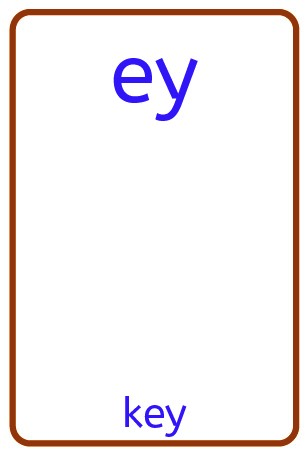What do Children Need to Know?
Children must understand the relationship between phonemes and graphemes, i.e., they must learn sound-letter relationships and spelling patterns such that they are enabled to decode (segment and blend sounds) and encode (spell) words.
CardEd Graphemes
The content of the Letter Zone of each CardEd deck is outlined below.
Note: You may find it useful to cut your CardEd cards into zones (as pictured) as this may make the activities suggested in this post easier for the child to manage.
CardEd Set 1 cards contain the vowels (in red) and consonants (in black) and can be used for letter identification, letter names and sounds, and early phonics activities.

CardEd Set 2 cards feature initial consonant clusters and digraphs (in blue). Vowels (in red) are again included. In set 2, y is printed in red to support introducing its function as a vowel in some words. Some consonants (in black) are also included. F, L, R, S, and Z are produced in single and double format (f/ff) to be used to demonstrate how they are often doubled at the end of one syllable words with a single vowel.

CardEd Set 3 cards introduce final consonant clusters and digraphs (in green). The vowels (red) and some consonants (black) are also included. Sets 2 and 3 can be compared to see which clusters / digraphs can function at the beginning and end of words.

CardEd Set 4 cards feature common vowel graphemes. These are colour-coded according to their sound. Attention is drawn to accent and dialect differences in our comprehensive CardEd Activity Guide.

The CardEd Activity Guide contains a comprehensive range of activities to support phonics development. 4 examples are shown below.
Letter Recognition (Set 1)
•Can the child state the letter name and sound of each vowel and consonant when shown a card?
•Can the child do this for capital and lower-case letters?
•From a set of cards placed face-up on the table, can the child select the correct letter when given a letter name or sound?
•If not, how many letters and sounds are known to the child and which ones are they yet to learn?
Extensions:
•Can the child distinguish between vowels and consonants?
•Can the child write the letters (upper and lower case) correctly?

I Spy (Set 2)
•Pick a card from the deck and use as the basis for I Spy.
•I spy with my little eye something beginning with… (the cluster on the card).
•Can the child find things in the environment with the particular cluster?
Extensions:
•Can the child give the clues?

Blending (Set 3)
•Review to check all sounds are known.
•Have the child sort CardEd Set 3 cards into consonants, vowels, and clusters / digraphs.
•Stack the vowels and digraphs / clusters cards in 2 piles. Have the child turn over one card from each pile – can they blend and say the VCC phoneme?
•Stack the consonants, vowels, and digraphs / clusters cards in 3 piles. Have the child turn over one card from each pile – can they read the CVCC word they have just made? Is it a real or made-up word? If real, can the child explain its meaning? Can (s)he use it in a sentence? Can the child think of words (real / nonsense) that rhymes with it?
•When the child is given a phoneme / word, can they form it using the CardEd cards and/or can they write it down?
Extensions:
•Are there any ending digraphs / clusters that can also occur at the beginning of words?
If you own sets 2 and 3, try using initial digraph / cluster cards, vowel cards, and ending digraph / cluster cards to have the child create CCVCC words

Introducing -ay (Set 4)
•English words do not end with i, u, v, or j.
•Remind the child to use –ay instead of –ai at the end of words. (Note: V must be followed by e and words ending in /j/ will have –ge/-dge endings, depending on whether the vowel sound is long / short, e.g., rage / badge.)
•Can the child say the sound?
•Use the consonant cards (Set 1) together with the –ay card to create –ay words Can the child identify words that are real? Can they use them in a sentence that makes sense?
Extensions:
•Use the digraph / cluster cards from CardEd Set 2 to further build on this. Identify the real words that have been made and use them in sentences.
•Have the child use the CardEd cards to make words you call out, or have them write them down.
•Try dictation exercises based on –ay words.
•Secure understanding will form the basis for later reading 2- and 3- syllable words ending with –ay, e.g., satay, betray, slipway, yesterday and containing –ay, e.g. crayon and daydreamer.
•You may wish to use the lists below for assessment purposes

We hope this gives you an idea of the many ways CardEd can be used to support phonics development and lay the foundation for reading and spelling success.
